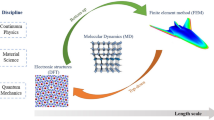Abstract
Traditionally, model calibration is formulated as a single objective problem, where fidelity to measurements is maximized by adjusting model parameters. In such a formulation however, the model with best fidelity merely represents an optimum compromise between various forms of errors and uncertainties and thus, multiple calibrated models can be found to demonstrate comparable fidelity producing non-unique solutions. To alleviate this problem, the authors formulate model calibration as a multi-objective problem with two distinct objectives: fidelity and robustness. Herein, robustness is defined as the maximum allowable uncertainty in calibrating model parameters with which the model continues to yield acceptable agreement with measurements. The proposed approach is demonstrated through the calibration of a finite element model of a steel moment resisting frame.















Similar content being viewed by others
References
Atamturktur S, Hemez F, Williams B, Tome C, Unal C (2011) A forecasting metric for predictive modeling. Comput Struct 89(23–24):2377–2387
Bekey GA, Masri SF (1983) Random search techniques for optimisation of nonlinear systems with many parameters. Math Comput Simul 25:210–213
Ben-Haim Y (2004) Uncertainty, probability and information-gaps. Reliab Eng Syst Saf 85:249–266
Ben-Haim Y (2006) Info-gap decision theory: decisions under sever uncertainty, 2nd edn. Academic, Oxford
Ben-Haim Y (2012) Modeling and design of a Hertzian contact: an info-gap approach. J Strain Anal Eng Des 47(3):153–162
Ben-Haim Y, Hemez FM (2012) Robustness, fidelity and prediction-looseness of models. Proc R Soc A 468:227–244
Ben-Haim Y, Cogan S, Sanseigne L (1998) Usability of mathematical models in mechanical decision processes. Mech Syst Signal Process 12:121–134
Berman A (1995) Multiple acceptable solutions in structural model improvement. AIAA 33(5):924–927
Cagkan E, Selin C, Andy D (2006) Multiobjective optimization and evolutionary algorithms for the application mapping problem in multiprocessor system-on-chip design. IEEE Trans Evol Comput 10(3):358–374
Campbell K (2006) Statistical calibration of computer simulations. Reliab Eng Syst Saf 91(10–11):1358–1363
Deb K, Gupta S (2010) Understanding knee points in bicriteria problems and their implications as preferred solution principles. Kanpur Genetic Algorithms Laboratory (KanGAL), KanGAL Report Number 2010005
Deb K, Pratap A, Agarwal S (2002) A fast and elitist multiobjective genetic algorithm: NSGA-II. IEEE Trans Evol Comput 6(2):182–197
Draper D (1995) Assessment and propagation of model uncertainty. J R Stat Soc Ser B 57(1):45–97
Farajpour I, Atamturktur S (2013) Error and uncertainty analysis of inexact and imprecise computer models. J Comput Civ Eng 27(4):407–418
Franchini M, Galeati G, Berra S (1998) Global optimization techniques for the calibration of conceptual rainfall–runoff models. Hydrol Sci J 43(3):443–458
Hemez FM, Ben-Haim Y (2004) Info-gap robustness for the correlation of tests and simulations of a nonlinear transient. Mech Syst Signal Process 18:1443–1467
Higdon D, Kennedy M, Cavendish JC, Cafeo J, Ryne RD (2004) Combining field data and computer simulations for calibration and prediction. SIAM J Sci Comput 26(2):448–466
Higdon D, Gattiker J, Williams B, Rightley M (2007) Computer model validation using high-dimensional outputs. In: Bernardo J, Bayarri MJ, Berger JO, Dawid AP, Heckerman D, Smith AFM, West M (eds) Bayesian statistics, vol. 8. Oxford University Press, Oxford
Ibarra LF, Medina RA, Krawinkler H (2005) Hysteretic models that incorporate strength and stiffness deterioration. Earthquake Eng Struct Dyn 34:1489–1511
Kennedy MC, O’Hagan A (2001) Bayesian calibration of computer models. J R Stat Soc Ser B 63(3):425–464
Lignos DG, Krawinkler H (2009) Sidesway collapse of deteriorating structural systems under seismic excitations. Rep. No. TB 172, The John A. Blume Earthquake Engineering Center, Stanford Univ., Stanford, CA
Lignos DG, Krawinkler H (2011) Deterioration modeling of steel beams and columns in support to collapse prediction of steel moment frames. ASCE J Struct Eng 137(11):1291–1302
Lobo FG, Lima CF, Michalewicz Z (2007) Parameter setting in evolutionary algorithms, Springer Publishing Company, ISBN:3540694315 9783540694311
Luce CH, Cundy TW (1994) Parameter identification for a runoff model for forest roads. Water Resour Res 30(4):1057–1069
Ma T, Abdulhai B (2001) Genetic algorithm-based combinatorial parametric optimization for the calibration of microscopic traffic simulation models. Intelligent Transportation Systems Conf. Proc, IEEE, New Brunswick, NJ, 848–853
Marler RT, Arora JS (2004) Survey of multi-objective optimization methods for engineering. Struct Multidiscip Optim 26(6):369–395
Mattsson H, Klisinski M, Axelsson K (2001) Optimization routine for identification of model parameters in soil plasticity. Int J Numer Anal Methods Geomech 25:435–472
Nagai A, Kadoya M (1979) Optimization techniques for parameter identification of runoff models. Annual Report of Disaster Prevention Research Institute in Kyoto Univ., 22:(B-2)
Solomatinée DP (1999) Random search methods in model calibration and pipe network design. In: Savic D, Walters G (eds) Water industry systems. modelling and optimization applications, vol. 2. Res. Stud, Baldock, pp 317–332
Zhang X, Srinivasan R, Zhao K, Liew MV (2009) Evaluation of global optimization algorithms for parameter calibration of a computationally intensive hydrologic model. Hydrol Process 23(3):430–441
Author information
Authors and Affiliations
Corresponding author
Rights and permissions
About this article
Cite this article
Atamturktur, S., Liu, Z., Cogan, S. et al. Calibration of imprecise and inaccurate numerical models considering fidelity and robustness: a multi-objective optimization-based approach. Struct Multidisc Optim 51, 659–671 (2015). https://doi.org/10.1007/s00158-014-1159-y
Received:
Revised:
Accepted:
Published:
Issue Date:
DOI: https://doi.org/10.1007/s00158-014-1159-y




